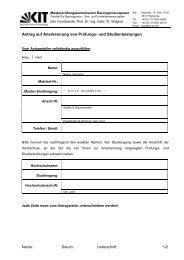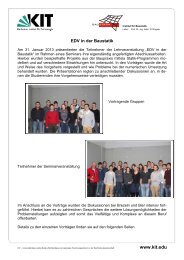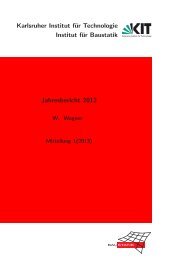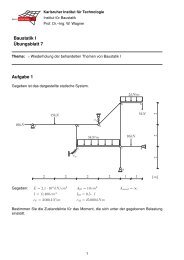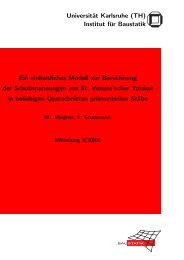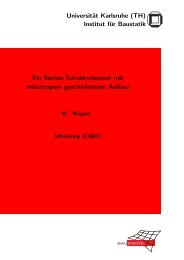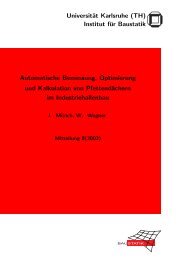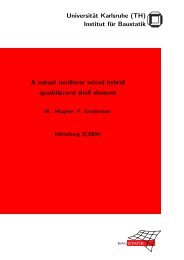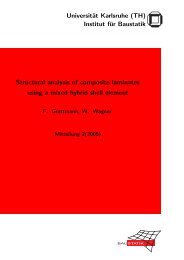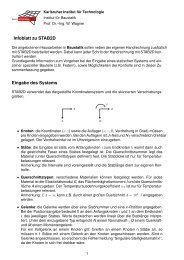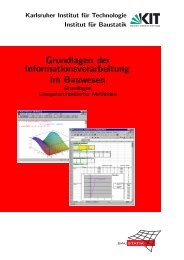Karlsruher Institut für Technologie Institut für Baustatik Adhesive ...
Karlsruher Institut für Technologie Institut für Baustatik Adhesive ...
Karlsruher Institut für Technologie Institut für Baustatik Adhesive ...
- No tags were found...
Create successful ePaper yourself
Turn your PDF publications into a flip-book with our unique Google optimized e-Paper software.
total shear energy release rate G shear and the mode mixing ratio has to be defined as the ratio between the total shearenergy release rate G shear and the total energy release rate G T . For the BK-criterion this method exemplarily yieldsG c = G Ic + ( G c,shear − G Ic) β η , (24)where G c,shear is taken from Eq. (23) andβ = G shear /G T . The authors emphasize that this approach is an assumptionand is not validated through experimental investigations. Actually, it is presently not possible to validate this approachsince there is no mixed mode I/II/III test method available. Also the single mode III CERR has to be determined byexperiments which has not been done in the framework of this paper. As long as experimental data are not availablefor single mode III the assumption of equal CERRs for single mode II and III may be a reasonable approximation.5. ConclusionsIn this paper a combined numerical/experimental approach was presented for the determination of the mixedmode critical energy release rate of adhesive joints in composite laminates. The material under investigation was aunidirectional Hexcel IM7/8552 carbon/epoxy composite which was connected by the film adhesive Cytec FM 300M.Experimental investigations have been carried out including classical delamination tests such as double cantileverbeam, end notched flexure, and mixed mode bending tests where the co-cured interface was replaced by an adhesivebond. The experimental outcome was presented by means of global load-deformation curves and provides an importantdatabase for single mode I, single mode II, and mixed mode I/II loading conditions. Since in the MMB case itwas not clear which initiation fracture toughness is useful for failure analyses, numerical simulations were performedin the framework of the finite element method, including state-of-the-art shell elements for the composite layers andinterface elements with an embedded cohesive law for the adhesive. The numerical approach was first validated onsimulations with co-cured interfaces before the results of the adhesive simulations were presented. Unfortunately,utilizing the CERRs from the experiments did not yield correlation with the tests. Thus the finite element simulationswere fitted against the experiments by trial-and-error variation of the CERR values. These values were then interpretedas the real CERRs. Since the CERR is different for different mode mixing ratios fracture toughness criteriafrom literature were evaluated and fitted against the CERR values for the mode mixing ratios under investigation.This led to mathematical expressions which gave the CERR as a function of the mode mixing ratio. The best fit incombination with physical plausibility was obtained for the so-called BK-criterion [60]. Finally, a simple method forincluding mode III behavior was described which relies on some basic assumptions.The relation between the fracture toughness and the mode mixing ratio is the key outcome of this paper. It is importantto know that the CERR is the major material parameter characterizing the fracture process within an adhesive.Hence, this paper forms a useful basis for failure analyses of a respective adhesive joint. This is exceptionally true asthe investigated materials are standard in the aircraft industry. The specific results now have to be validated on morecomplex structures before final proof of their quality.AcknowledgementsThe authors kindly acknowledge the financial support of the European Commission, Priority Aeronautics andSpace, Contract AST3–CT–2003–502723. The authors further gratefully acknowledge the fruitful cooperation withall partners involved in the COCOMAT project [57, 58].23



